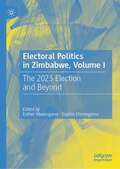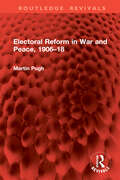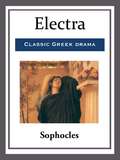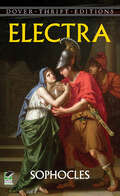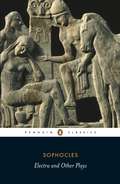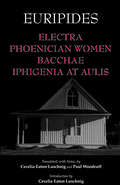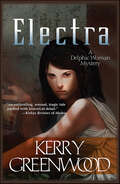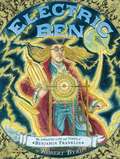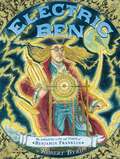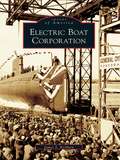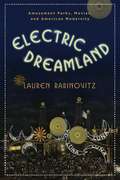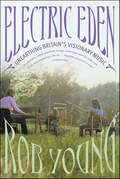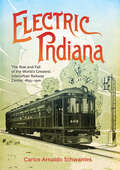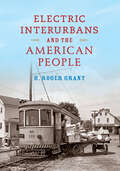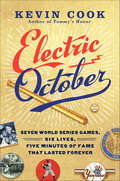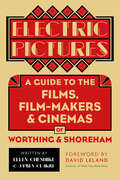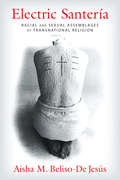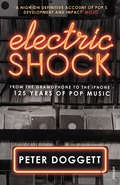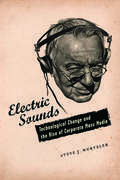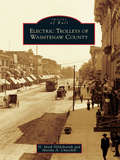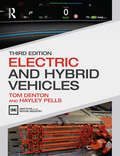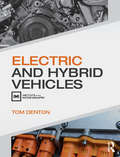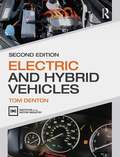- Table View
- List View
Electoral Politics in Zimbabwe, Volume I: The 2023 Election and Beyond
by Sophia Chirongoma Esther MavenganoVolume one of Electoral Politics in Zimbabwe pays special attention to the overarching view that the 2023 harmonized elections define the fate of the major presidential contenders and their parties as well as (re) shaping the political and economic trajectories of the nation. Cognizant of the complex nature of the Zimbabwean political realm and nuanced dynamics at play, the chapters in this volume cover three interrelated themes: the electoral environment in Zimbabwean politics; language, politics, and elections in Zimbabwe; and lastly, electoral institutions and human rights in Zimbabwean politics. The chapters foreground the ongoing tensions and politicking between the two main rivals, the ruling party, ZANU PF and the main opposition party, the Citizens Coalition for Change (CCC). The contributors also highlight the impact of internal tensions and factionalism within the contending parties, the apparent voter apathy, disconcerting voices due to claims about lack of transparency and a toxic political space as factors impacting on the outcome of the 2023 presidential elections. The volume will appeal to academics and practitioners in politics, human rights, religion, gender, media, languages, linguistics, and development studies.
Electoral Reform and National Security in Japan
by Amy CatalinacJapan is the third-largest economy in the world and a key ally of the United States. Yet the determinants of Japanese security policy are not well understood. The question of why Japan never sought the independent military capabilities that would be commensurate with its economic power has puzzled scholars of international relations for decades. Applying new tools for the quantitative analysis of text to a new collection of 7,497 Japanese-language election manifestos used in elections between 1986 and 2009, this book argues that the electoral strategies politicians in the ruling party were forced to adopt under Japan's old electoral system made it extraordinarily difficult for them to focus on security issues and to change security policy. It was only when their electoral strategies shifted after electoral reform in 1994 that these same politicians became able to pay attention and change security policy.
Electoral Reform in War and Peace, 1906–18 (Routledge Revivals)
by Martin PughThe Fourth Parliamentary Reform Act of 1918 gave the vote to nearly thirteen million men and over eight million women and determined the structure of electoral politics in twentieth-century Britain. Electoral Reform in War and Peace, 1906–18 (originally published in 1978) is the first attempt to explain this turning-point; it does so partly by exploring the relationship between reform of the franchise and reform of the electoral system between 1906 and 1918. The author’s analysis of the debate on Proportional Representation and the Alternative Vote sheds new light on the Liberal-Labour relationship in this period and shows why the Liberal and Labour Parties failed to reform the electoral system in 1917–18, thereby exposing themselves to twenty years of Conservative hegemony under the democratic franchise.The book attacks the status conventionally accorded to the militant suffragettes, particularly the Pankhursts, in the achievement of votes for women; it argues that the Pankhursts played a negligible role, at best, after 1914, and that the real progress made before the war was the work of the non-militant women largely ignored by historians. The author also offers a reinterpretation of wartime politics as a struggle over the timing of the General Election delayed from 1915 to 1918 and shows how this led to the emergence of a Reform Bill, more by accident than by design, through the innovation of the Speaker’s Conference. He considers the struggle over the Bill itself and the light thereby thrown upon the decline of the Liberal Party.Finally, the book analyses the relationship between wartime experience and political reform by arguing that reform grew essentially out of pre-war conditions, and by demonstrating how resilient attitudes remained under the impact of popular participation in the Great War. This forms a salutary corrective to the assumption that twentieth-century mass warfare had a democratising effect on British society.
Electra
by SophoclesSet in the city of Argos a few years after the Trojan war, 'Electra' recounts the tale of Electra and the vengeance that she and her brother Orestes take on their mother Clytemnestra and step father Aegisthus for the murder of their father, Agamemnon.
Electra
by SophoclesMasterpiece of drama concerns the revenge Electra takes on her mother for the murder of her father. One of the best-known heroines of all drama and a towering figure of Greek tragedy.
Electra and Other Plays: Ajax, Women Of Trachis, Electra, And Philoctetes
by SophoclesSophocles’ innovative plays transformed Greek myths into dramas featuring complex human characters, through which he explored profound moral issues. Electra portrays the grief of a young woman for her father Agamemnon, who has been killed by her mother’s lover. Aeschylus and Euripides also dramatized this story, but the objectivity and humanity of Sophocles’ version provides a new perspective. Depicting the fall of a great hero, Ajax examines the enigma of power and weakness combined in one being, while the Women of Trachis portrays the tragic love and error of Heracles’ deserted wife Deianeira, and Philoctetes deals with the conflict between physical force and moral strength.
Electra, Phoenician Women, Bacchae, and Iphigenia at Aulis
by Euripides Paul Woodruff Cecelia Eaton LuschnigThe four late plays of Euripides collected here, in beautifully crafted translations by Cecelia Eaton Luschnig and Paul Woodruff, offer a faithful and dynamic representation of the playwright’s mature vision.
Electra: A Delphic Woman Novel (Delphic Women Series #3)
by Kerry Greenwood"Greenwood fans will welcome her thoughtful second reinterpretation of a well-known Greek myth. Among Greenwood's other talents, she displays a gift for writing songs of the period." —Publishers Weekly STARRED reviewIn this, the third and final book in Kerry Greenwood's Delphic Women series, Greenwood takes us into Troy as it struggles to rise from the ashes of the Trojan War. But while others have told the story as a struggle of men, Greenwood gives this mythology a compelling and exciting female viewpoint.The women of Troy are in terrible transition. Cassandra, the tragic heroine of the second Delphic Woman novel, is King Agamemnon's captive. Queen Clytemnestra has taken a lover who has thrown her own loyalties into question. And then there's Electra, daughter of Clytemnestra and Agamemnon. What compels the young beauty? What secret is she hiding? What are her intentions? Are they dark or justified?Cast aside everything you think you know about the Electra myth and allow yourself to view this classic story from a different perspective. Greenwood's conclusions will surprise and enrapt you.
Electric Ben: The Amazing Life and Times of Benjamin Franklin
by Robert ByrdBeing one of the most far-sighted of the early American leaders, Benjamin Franklin possessed a brilliant, questioning mind which drove him to achieve success in a remarkable variety of enterprises--as a scientist, writer, inventor, philosopher, publisher, and statesman. <P><P> Winner of the Sibert Honor
Electric Ben: The Amazing Life and Times of Benjamin Franklin
by Robert ByrdElectric Ben is now a 2013 Boston Globe-Horn Book Nonfiction Book Award Winner, a Kirkus Reviews Best Children's Book, a Horn Fanfare Book, and a Robert F. Sibert Honor book!“a true standout…bright, witty, informative and cleverly organized as the man himself.” – The New York TimesA true Renaissance man, Benjamin Franklin was the first American celebrity. In pictures and text, master artist Robert Byrd documents Franklin's numerous and diverse accomplishments, from framing the Constitution to creating bifocals. The witty, wise, and endlessly curious Franklin is the perfect subject for Byrd's lively style and vibrant art. The pages pulse with facts, quotes, and captions, while the inventive design and intricately detailed illustrations make a striking tribute to the brilliant American.
Electric Boat Corporation
by James S. ReyburnElectric Boat Corporation has been a world leader in submarine development, design, and construction for more than a century. In 1900, the company delivered the Holland, the first submarine accepted by the United States Navy. Fifty-five years later, it turned fantasy into fact by sending the world's first nuclear-powered ship, the submarine Nautilus, off on its maiden voyage. It later built the world's first ballisticmissile-firing submarine, the George Washington, and most of the nation's current underseas fleet. Between those years, it pioneered standardized construction of merchant ships, submarine chasers, torpedo boats, and yachts and also produced airplanes, fishing trawlers, diesel engines, and electric motors. This collection of more than 200 archival photographs traces the company's sometimes roller-coaster existence through 10 historic decades when America--and Electric Boat Corporation--grew into an industrial giant. It is an engaging collective portrait of American ingenuity, know-how, and persistence driving technology to new heights.
Electric Dreamland: Amusement Parks, Movies, and American Modernity (Film and Culture Series)
by Lauren RabinovitzAmusement parks were the playgrounds of the working class in the early twentieth century, combining numerous, mechanically-based spectacles into one unique, modern cultural phenomenon. Lauren Rabinovitz describes the urban modernity engendered by these parks and their media, encouraging ordinary individuals to sense, interpret, and embody a burgeoning national identity. As industrialization, urbanization, and immigration upended society, amusement parks tempered the shocks of racial, ethnic, and cultural conflict while shrinking the distinctions between gender and class. Following the rise of American parks from 1896 to 1918, Rabinovitz seizes on a simultaneous increase in cinema and spectacle audiences and connects both to the success of leisure activities in stabilizing society. Critics of the time often condemned parks and movies for inciting moral decline, yet in fact they fostered women's independence, racial uplift, and assimilation. The rhythmic, mechanical movements of spectacle also conditioned audiences to process multiple stimuli. Featuring illustrations from private collections and accounts from unaccessed archives, Electric Dreamland joins film and historical analyses in a rare portrait of mass entertainment and the modern eye.
Electric Eden: Unearthing Britain's Visionary Music
by Rob YoungA Kirkus Reviews Best Nonfiction of 2011 title In the late 1960s, with popular culture hurtling forward on the sounds of rock music, some brave musicians looked back instead, trying to recover the lost treasures of English roots music and update them for the new age. The records of Fairport Convention, Pentangle, Steeleye Span, and Nick Drake are known as "folk rock" today, but Rob Young's epic, electrifying book makes clear that those musicians led a decades-long quest to recover English music-and with it, the ancient ardor for mysticism and paganism, for craftsmanship and communal living.It is a commonplace that rock and R&B came out of the folk and blues revivals of the early 1960s, and Young shows, through enchanting storytelling and brilliant commentary, that a similar revival in England inspired the Beatles and Pink Floyd, Led Zeppelin and Traffic, Kate Bush and Talk Talk. Folklorists notated old songs and dances. Marxists put folk music forward as the true voice of the people. Composers like Benjamin Britten and Ralph Vaughan Williams devised rich neo-traditional pageantry. Today, the pioneers of the "acid folk" movement see this music as a model for their own.Electric Eden is that rare book which has something truly new to say about popular music, and like Greil Marcus's LipstickTraces, it uses music to connect the dots in a thrilling story of art and society, of tradition and wild, idiosyncratic creativity.
Electric Indiana: The Rise and Fall of the World's Greatest Interurban Railway Center, 1893–1941 (Railroads Past and Present)
by Carlos Arnaldo SchwantesIn the early twentieth century, an epic battle was waged across America between the interurban railway and the automobile, two technologies that arose at roughly the same time in the late 1890s. Nowhere was this conflict more evident than in the Midwest, and specifically Indiana, where cities of industry such as Indianapolis, Gary, and Terre Haute were growing faster every day. By 1904, Indianapolis had opened the Traction Terminal, which was widely acclaimed to be the largest and most impressive interurban station in the world. Yet, today there is only 90-mile remnant of this one great system still operating within Indiana.Featuring over 90 illustrations and featuring contemporary accounts and newspaper articles from the period, Electric Indiana is a biographical study of the rise and fall of a onetime important transportation technology that achieved its most impressive development within the Hoosier state.
Electric Interurbans and the American People (Railroads Past and Present)
by H. Roger Grant“A well-written social history of the shortest-lived major US transportation mode” from the railway historian and author of A Mighty Fine Road (Choice).One of the most intriguing yet neglected pieces of American transportation history, electric interurban railroads were designed to assist shoppers, salesmen, farmers, commuters, and pleasure-seekers alike with short distance travel. At a time when most roads were unpaved and horse and buggy travel were costly and difficult, these streetcar-like electric cars were essential to economic growth. But why did interurban fever strike so suddenly and extensively in the Midwest and other areas? Why did thousands of people withdraw their savings to get onto what they believed to be a “gravy train?” How did officials of competing steam railroads respond to these challenges to their operations? H. Roger Grant explores the rise and fall of this fleeting form of transportation that started in the early 1900s and was defunct just 30 years later. Perfect for railfans, Electric Interurbans and the American People is a comprehensive contribution for those who love the flanged wheel.“With this book, the subject no longer has footnote status. In fact, Grant’s work deserves a place alongside some of the other landmark surveys of the subject . . . Here, Grant moves beyond the receiverships, the rickety track, and all that fascinating rolling stock. He shows us why the whole darned thing mattered.” —Railroad History“H. Roger Grant has produced a fine social history of America’s electric interurbans, exploring the relationship between people and those railway enterprises. The book fills a void, is eminently readable, and richly illustrated.” —Don L. Hofsommer, author of Off the Main Lines
Electric October: Seven World Series Games, Six Lives, Five Minutes of Fame That Lasted Forever
by Kevin CookAn “entertaining, well-researched” account of the first World Series to be televised—and the forgotten stories of six Yankees and Dodgers (Publishers Weekly, starred review).The 1947 World Series was “the most exciting ever” in the words of Joe DiMaggio, with a decade’s worth of drama packed into seven games between the mighty New York Yankees and underdog Brooklyn Dodgers. It was Jackie Robinson’s first Series, a postwar spectacle featuring Frank Sinatra, Ernest Hemingway and President Harry Truman in supporting roles. It was also the first televised World Series—sportswriters called it “Electric October.”But for all the star power on display, the outcome hinged on role players: Bill Bevens, a journeyman who knocked on the door of pitching immortality; Al Gionfriddo and Cookie Lavagetto, bench players at the center of the Series’ iconic moments; Snuffy Stirnweiss, a wartime batting champion who never got any respect; and managers Bucky Harris and Burt Shotton, each an unlikely choice to run his team. Six men found themselves plucked from obscurity to shine on the sport’s greatest stage. But their fame was fleeting; three would never play another big-league game, and all six would be forgotten.Kevin Cook brings the ‘47 Series back to life, introducing us to men whose past offered no hint they were destined for extraordinary things. For some, the Series was a memory to hold on to. For others, it would haunt them to the end of their days. And for us, Cook offers new insights—some heartbreaking, some uplifting—into what fame and glory truly mean.“A wonderful book.” —Ken Burns“Impressively reported, smoothly written.” —Kirkus Reviews“Mr. Cook evokes earlier books by Roger Kahn, Peter Golenbock and David Halberstam in a poignant study that goes beyond baseball and its immortals, like Jackie Robinson and Joe DiMaggio . . . His thoroughly researched narrative probes their personalities [and] relives the gladiatorial 1947 rivalry between the two hometown teams, game by game.” —The New York TimesIncludes photographs
Electric Pictures: A Guide to the Films, Film-Makers & Cinemas of Worthing & Shoreham
by James Clarke Ellen Cheshire David LelandWritten as part of the Worthing WOW festival celebrations, Electric Pictures commemorates 120 years of film in the Sussex coastal towns of Worthing and Shoreham, capturing the region’s rich cinematic legacy and its place in British film history. From film-making pioneers through to blockbuster films and key events in the film history of the coast, this volume draws on research from film archives and local history resources to tell the story of the south coast film world. Richly illustrated and featuring contributions from local historians and film and theatre specialists, this book also includes an additional Heritage Trail guide that reveals key filming locations and the towns’ cinemas.
Electric Santería: Racial and Sexual Assemblages of Transnational Religion (Gender, Theory, and Religion)
by Aisha Beliso-De JesúsSantería is an African-inspired, Cuban diaspora religion long stigmatized as witchcraft and often dismissed as superstition, yet its spirit- and possession-based practices are rapidly winning adherents across the world. Aisha M. Beliso-De Jesús introduces the term "copresence" to capture the current transnational experience of Santería, in which racialized and gendered spirits, deities, priests, and religious travelers remake local, national, and political boundaries and reconfigure notions of technology and transnationalism.Drawing on eight years of ethnographic research in Havana and Matanzas, Cuba, and in New York City, Miami, Los Angeles, and the San Francisco Bay area, Beliso-De Jesús traces the phenomenon of copresence in the lives of Santería practitioners, mapping its emergence in transnational places and historical moments and its ritual negotiation of race, imperialism, gender, sexuality, and religious travel. Santería's spirits, deities, and practitioners allow digital technologies to be used in new ways, inciting unique encounters through video and other media. Doing away with traditional perceptions of Santería as a static, localized practice or as part of a mythologized "past," this book emphasizes the religion's dynamic circulations and calls for nontranscendental understandings of religious transnationalisms.
Electric Shock: From the Gramophone to the iPhone – 125 Years of Pop Music
by Peter DoggettAmbitious and groundbreaking, Electric Shock tells the story of popular music, from the birth of recording in the 1890s to the digital age, from the first pop superstars of the twentieth century to the omnipresence of music in our lives, in hit singles, ringtones and on Spotify. Over that time, popular music has transformed the world in which we live. Its rhythms have influenced how we walk down the street, how we face ourselves in the mirror, and how we handle the outside world in our daily conversations and encounters. It has influenced our morals and social mores; it has transformed our attitudes towards race and gender, religion and politics. From the beginning of recording, when a musical performance could be preserved for the first time, to the digital age, when all of recorded music is only a mouse-click away; from the straitlaced ballads of the Victorian era and the ‘coon songs’ that shocked America in the early twentieth century to gangsta rap, death metal and the multiple strands of modern dance music: Peter Doggett takes us on a rollercoaster ride through the history of music. Within a narrative full of anecdotes and characters, Electric Shock mixes musical critique with wider social and cultural history and shows how revolutionary changes in technology have turned popular music into the lifeblood of the modern world.
Electric Sounds: Technological Change and the Rise of Corporate Mass Media
by Stephen WurtzlerA history of sound recording and reproduction and how this technology transformed American mass media.
Electric Sounds: Technological Change and the Rise of Corporate Mass Media (Film and Culture Series)
by Steve WurtzlerElectric Sounds brings to vivid life an era when innovations in the production, recording, and transmission of sound revolutionized a number of different media, especially the radio, the phonograph, and the cinema. The 1920s and 1930s marked some of the most important developments in the history of the American mass media: the film industry's conversion to synchronous sound, the rise of radio networks and advertising-supported broadcasting, the establishment of a federal regulatory framework on which U.S. communications policy continues to be based, the development of several powerful media conglomerates, and the birth of a new acoustic commodity in which a single story, song, or other product was made available to consumers in multiple media forms and formats.But what role would this new media play in society? Celebrants saw an opportunity for educational and cultural uplift; critics feared the degradation of the standards of public taste. Some believed acoustic media would fulfill the promise of participatory democracy by better informing the public, while others saw an opportunity for manipulation. The innovations of this period prompted not only a restructuring and consolidation of corporate mass media interests and a shift in the conventions and patterns of media consumption but also a renegotiation of the social functions assigned to mass media forms. Steve J. Wurtzler's impeccably researched history adds a new dimension to the study of sound media, proving that the ultimate form technology takes is never predetermined. Rather, it is shaped by conflicting visions of technological possibility in economic, cultural, and political realms. Electric Sounds also illustrates the process through which technologies become media and the ways in which media are integrated into American life.
Electric Trolleys of Washtenaw County (Images of Rail)
by H. Mark Hildebrandt Martha A. ChurchillElectric streetcars and interurbans appeared in Washtenaw County in the 1890s. Evolved from horse-drawn streetcars, electric cars were ideal for public transportation. They were cheap, fast, and went to plenty of places. The system developed around Ann Arbor and Ypsilanti, branching out to Detroit to the east and Jackson to the west. Bigger and better equipment was added, and larger companies took over the small ones. In western Washtenaw County, two interurban railways engaged in a struggle for survival. Occasionally the interurbans crashed into buildings or one another, with disastrous results. Electric Trolleys of Washtenaw County explains how electric mass transportation flourished starting in the 1890s, why it bloomed, and why it suddenly became extinct after only a few decades.
Electric and Hybrid Vehicles
by Tom Denton Hayley PellsElectric and hybrid vehicles are now the present, not the future. This straightforward and highly illustrated full-colour textbook is endorsed by the Institute of the Motor Industry (IMI) and introduces the subject for further education and undergraduate students as well as technicians and workshop owners, with sections for drivers who are interested to know more. This new edition contains extensively updated content, especially on batteries, charging and the high-voltage pathway and includes all new case studies and new images, photos and flow charts throughout. It covers the different types of electric vehicle, costs and emissions and the charging infrastructure before moving on to explain how hybrid and electric vehicles work. A chapter on electrical technology introduces learners to subjects such as batteries, control systems and charging, which are then covered in more detail within their own chapters. The book also covers the maintenance and repair procedures of these vehicles, including diagnostics, servicing, repair and first-responder information. The book is particularly suitable for students studying towards IMI Level 1 Award in Hybrid Electric Vehicle Awareness, IMI Level 2 Award in Hybrid Electric Vehicle Operation and Maintenance, IMI Level 3 Award in Hybrid Electric Vehicle Repair and Replacement, IMI Level 4 Award in the Diagnosis, Testing and Repair of Electric/Hybrid Vehicles and Components, IMI accreditation, City & Guilds (C&G) and all other EV/hybrid courses.
Electric and Hybrid Vehicles
by Tom DentonThe first book on electric and hybrid vehicles (EVs) written specifically for automotive students and vehicle owners Clear diagrams, photos and flow charts outline the charging infrastructure, how EV technology works, and how to repair and maintain hybrid and electric vehicles Optional IMI online eLearning materials enable students to study the subject further and test their knowledge Full coverage of IMI Level 2 Award in Hybrid Electric Vehicle Operation and Maintenance, IMI Level 3 Award in Hybrid Electric Vehicle Repair and Replacement, IMI Accreditation, C&G and other EV/Hybrid courses. The first book on electric and hybrid vehicles (endorsed by the IMI) starts with an introduction to the market, covering the different types of electric vehicle, costs and emissions, and the charging infrastructure, before moving on to explain how hybrid and electric vehicles work. A chapter on electrical technology introduces learners to subjects such as batteries, control systems and charging which are then covered in more detail within their own chapters. The book also covers the maintenance and repair procedures of these vehicles, including fault finding, servicing, repair and first-responder information. Case studies are used throughout to illustrate different technologies.
Electric and Hybrid Vehicles
by Tom DentonElectric and hybrid vehicles are now the present, not the future. This straightforward and highly illustrated full colour textbook is endorsed by the Institute of the Motor Industry, and introduces the subject for further education and undergraduate students as well as technicians. This new edition includes a new section on diagnostics and completely updated case studies. It covers the different types of electric vehicle, costs and emissions, and the charging infrastructure, before moving on to explain how hybrid and electric vehicles work. A chapter on electrical technology introduces learners to subjects such as batteries, control systems and charging which are then covered in more detail within their own chapters. The book also covers the maintenance and repair procedures of these vehicles, including fault finding, servicing, repair and first-responder information. Clear diagrams, photos and flow charts outline the charging infrastructure, how EV technology works, and how to repair and maintain hybrid and electric vehicles. Optional IMI online eLearning materials enable students to study the subject further and test their knowledge. It is particularly suitable for students studying towards IMI Level 2 Award in Hybrid Electric Vehicle Operation and Maintenance, IMI Level 3 Award in Hybrid Electric Vehicle Repair and Replacement, IMI Accreditation, C&G and other EV/Hybrid courses.
